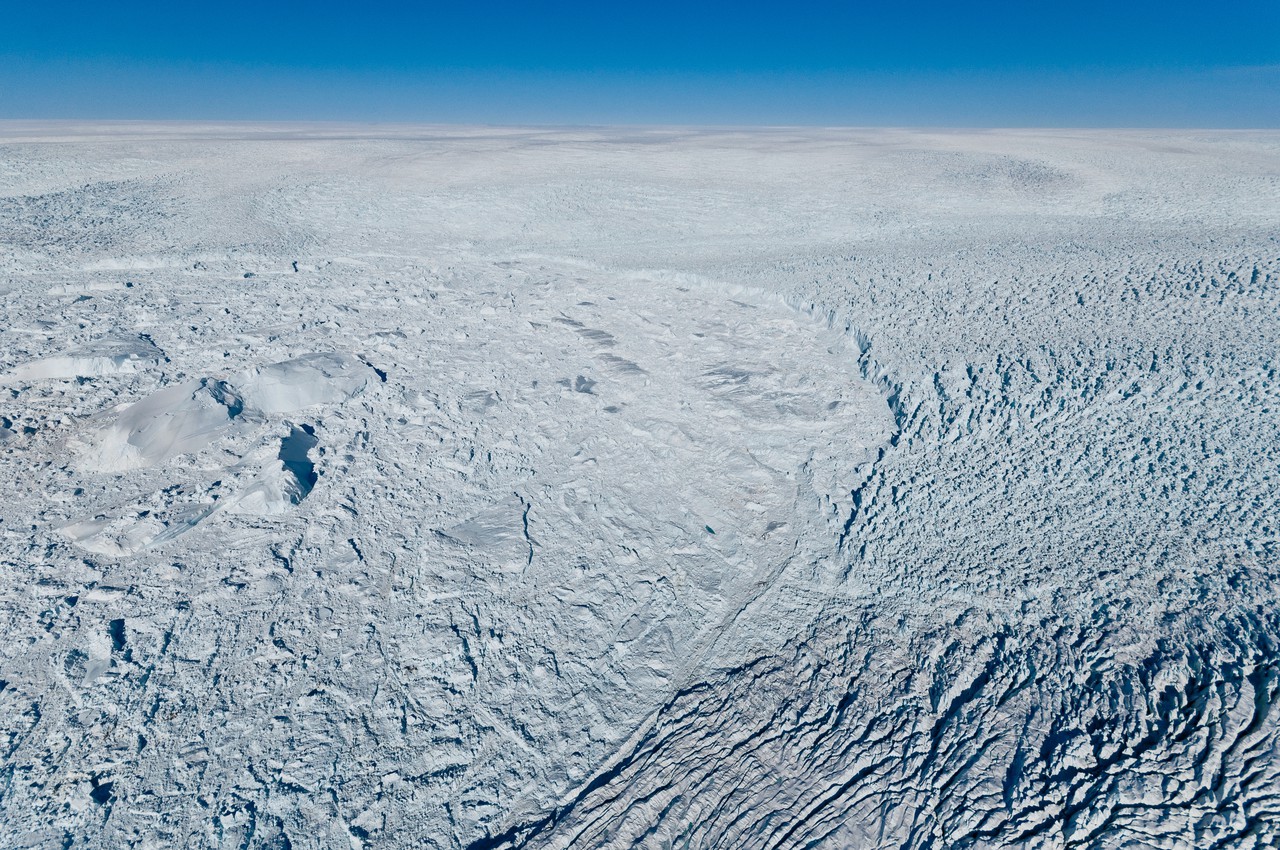Sign up for daily news updates from CleanTechnica on email. Or follow us on Google News!
Greenland is a self governing autonomous region of Denmark that still relies on Denmark for its economic support, defense and foreign relations. Why is that important? Because there is a glacier in Greenland that is deteriorating faster than almost any other glacier on Earth. Scientists are exploring ways to slow or stop the melting of the glacier, which is known as Jakobshavn by Danes but Sermeq Kujalleq by Greenlanders. Whether the scientists are allowed to pursue their plans to rescue the glaciers will require approval from both Denmark and Greenland, whose interests do not always align on matters of international policy.
According to the New York Times, Jakobshavn acts very much like a drain at the western edge of the Greenland ice sheet that moves between 30 billion and 50 billion tons of icebergs from the ice sheet every year. Icebergs, some as large as a tall building, break off regularly from the glacier, crash into a deep fjord below, and float west into Disko Bay. Then they drift out into the North Atlantic, break apart and melt. Scientists estimate meltwater from Jacobshavn is responsible for 4 percent of sea level rise in the past 100 years. The Jakobshavn glacier may contain enough ice to ultimately push sea levels up at least another foot.
The intense glacial activity at Jacobshavn, as well its breathtaking location, have earned the area a designation as a UNESCO World Heritage site and made it a powerful attraction for Greenland’s small but vibrant tourist trade. Hold that thought. It will become relevant to our discussion soon enough.
How To Save A Glacier
One day in 2016, a British glaciologist named John Moore attended a meeting in Cambridge, England, that included a presentation about Jakobshavn. He was struck not only by the potential for a collapse of the glacier but also the way its ice interacts with the surrounding water. A slide at the meeting showed how warm water nearly a thousand feet below the surface flows from the Atlantic into Disko Bay and eventually makes its way into the fjord and to the front of the glacier, where it carves away at and weakens the ice.
Moore noticed at the entrance to the fjord, warm water flows over a three mile long ridge that rises several hundred feet above the ocean floor. “It’s kind of a pity that sill isn’t just a bit higher,” Moore thought. “Because then it would stop the warm water from coming in and hitting the glacier.” Soon he started asking his collegues, “What if someone made the ridge higher?” For the next year, Moore mulled over that question. How hard would that be? How expensive? And how effectively could a raised sill halt the influx of warm water and slow Jakobshavn’s shrinkage?
In 2018, Moore and his colleague Michael Wolovick published an article that proposed building a sea wall 100 meters high on the floor of Disko Bay using gravel and sand. The higher ridge would reduce the warm water in the fjord and allow Jakobshavn to thicken naturally and stabilize. Moore believed that such a sea wall might not only decrease Greenland’s contribution to sea level rise, it might also serve as a trial run for a far grander ambition.
If the idea proved workable in the Arctic, it could be translated to Antarctica, where much larger glaciers in the Amundsen Sea, especially one known as Thwaites, threaten to raise sea levels by as much as two meters. “Should we spend vast sums to wall off all the world’s coasts,” Moore and Wolovick asked in Nature, “or can we address the problem at its source?”
A sea wall at Jakobshavn might cost $500 million. At Thwaites, one might run to more than $50 billion. Moore also understands the latter could represent the most difficult construction project in human history — one that would pose problems beyond costs and logistics.
Geoengineering Is About More Than Engineering

“Geoengineering” commonly refers to human interventions in Earth’s natural systems in order to reap societal benefits even in the face of unclear risks. In general, geoengineering seeks to reduce the impacts of climate change and to buy us more time as we transition to a zero-carbon world.
Such projects also confront advocates with extraordinary challenges of engineering and financing — as well as political, cultural and ethical obstacles. The glacial barrier proposed by Moore and Wolovick is a case in point. It is novel, expensive, complex, potentially risky, and controversial. Nevertheless, last year the two scientists turned their attention to determining if their idea could become more than a hypothetical.
Moore thought the path ahead would take at least a decade, beginning deep in a Norway fjord, then moving on to Greenland. An installation near Thwaites might take another decade. “No one has really said lately that it’s supercrazy,” he said, laughing. Still, some glaciologists have voiced strong opposition as well as skepticism. Also Moore and his team don’t know yet whether native Greenlanders would find his plans acceptable, or whether the political treaty in Antarctica would allow for construction.
As we get closer to reaching the point where Earth’s temperatures are 1.5 degrees Celsius greater than they were in pre-industrial times — a level we are likely to hit by the end of this decade — it seems increasingly clear that an age of geoengineering, both in prospect and in practice, has arrived. The resulting projects can often require complexity and sophistication. To disperse reflective particles to cool the Earth, for instance, may require manufacturing a fleet of specialized high-altitude aircraft. But geoengineering efforts can be low tech too. Painting urban roofs white to cool buildings is one example; covering permafrost or glaciers with blankets to keep them cool is another.
No single entity organizes geoengineering research projects or evaluates potential risks and effects; nor is there a clear process by which governments or other entities decide whether they are sensible or safe or affordable. Instead, academics like Moore are usually left to push their ideas forward independently and hope they find funding and momentum.
The need to evaluate the risks associated with geoengineering can make for wide gaps between research and deployment. Wolovick has noted that “humanity is a very long way from being able to implement any sort of targeted glacial engineering.” He said there are “so many scientific unknowns here in terms of the glaciology, the oceanography, the materials science, the marine biology.” All of them need to be studied in extraordinary detail — along with the necessary engineering studies.”
He sees it taking 20 years to learn how to install a glacial barrier in Antarctica. He is convinced it is important to know the engineering requirements and ecosystem impacts as big glaciers continue to degrade over those 20 years. If we aren’t prepared, at some panic point in the future a poorly studied geoengineering scheme might be attempted — with disastrous results, he says.
An underwater barrier might push warm water away from one vulnerable glacier and toward another, for instance, hastening the collapse of a different glacier. Moore says he is urgently interested in “emergency measures” for the Arctic, which appears to be warming four times as fast as the rest of the Earth.
Call In The Experts
Building structures underwater is not for amateurs. Moore and his colleagues decided to seek experts in the field, one of which is Aker Solutions, a global engineering firm with experience in underwater construction. “These are the big guys who build big ugly stuff in the water for the oil industry,” he said. “They are the ones who understand this,” Moore said.
Ole Wroldsen and Dorthe Julie Kirkeby both work for Aker. When they heard about Moore’s idea, they were concerned a barrier made of rocks could damage the seabed. Wroldsen theorized a tight mesh of sisal or abaca — durable natural fibers that sailors have used for centuries — might be strong and slippery enough.
The idea has morphed into something that resembles a gigantic, tightly knit tennis net that would rise up from the ocean floor for at least several hundred feet and stretch lengthwise, probably in paneled sections, for several miles in Greenland or 50 miles or so in Antarctica. It would be anchored by weights at various points but include gaps to allow nutrients and fish to pass underneath. It would flex “like a swinging saloon door,” Wroldsen said. If it proved ineffective, it could be severed from its anchors and allowed to float to the surface for removal.
Return On Investment
Constructing such a barrier in Antarctica would be expensive — $50 billion or more. Is it worth it? David Holland, an oceanographer at New York University, tells the New York Times, “We’ve struggled to get there, and it takes years to plan things. There are no second chances for anything. When you’re there, you’re far away from everything, and you have a small window of operations in the months of January and February when the temperature’s warm enough — and then boom, it’s cold again.”
On the other hand, he adds, there were few “pressure points” on Earth as important as Thwaites. “Thwaites could add two feet to sea levels — but then it could trigger its neighbor glaciers to add several more feet,” he says. “So you look at it and say, ‘Well, the cost to the world is Florida’s gone. Bangladesh is gone. Lots of little cities around the world are gone. Big cities, too, like Shanghai.’ I mean, the cost events are just so large it’s incomprehensible.”
A rough cost-benefit analysis for the curtain has been Moore and Wolovick’s central argument since the beginning — spend money locally, save money globally. A recent study put the future global costs from both the damages of sea-level rise and new coastal defenses at many hundreds of billions of dollars. Moore estimates that a curtain in Greenland that averts a rise of perhaps one-tenth of a meter might save $5 billion a year and a curtain in Antarctica that prevents a two meter rise might save $100 billion a year. The curtains could quickly pay for themselves.
Geoengineering And Geopolitics
The physical impediments to geoengineering schemes can be daunting, but political and cultural objections can be even harder to resolve. Antarctica — lacking countries and permanent residents — is governed by a complex international treaty. Any seabed curtain project there would very likely need the support of most of the more than two dozen countries with voting power. In Greenland, a similar intervention would depend on the permission of Inuit society, who make up a majority of the population.
Maybe disrupting a tourist industry in Greenland is not a big deal from a global perspective but it is vitally important to those who make their living from it. Lars Kullerud, president of the University of Lapland said, “Destroying an ecosystem in the Arctic means your idea will not go anywhere even if you save the world.”
The main concern of Greenlanders now is not climate change, says Carl Egede Bøggild, a glaciologist working at the education ministry in Nuuk, Greenland’s capital city. The island is focused on becoming financially and politically independent from Denmark. In trying to expand their economy, he says, Greenlanders might ask Moore, “Why should we pay for your Western-created problem of CO2 emissions?”
Sara Olsvig, a former member of the Greenlandic and Danish parliaments who now serves as the international chairwoman of the nonprofit Inuit Circumpolar Council, echoes this concern. Olsvig told the Times that Greenlanders are wary when outsiders talk about taking action for some greater good. “That is exactly what we have been experiencing as Indigenous peoples of the Arctic,” she says, “that our lands were colonized, our societies were colonized, in the greater good of someone else.”
Geoengineering And Moral Hazard
Perhaps the essential question about geoengineering is whether it is riskier for humanity to focus exclusively on reducing emissions in the coming years, adapting to a hotter world, or expandinh our research into climate interventions. “I just don’t agree with Greta Thunberg on this,” Moore said. Nor does he think that the risks of “moral hazard” — that by investing heavily in ways to alleviate the impacts of climate change we lose the motivation or resources to prevent its causes — are reason to pause his glacier research.
Moore believes we should be prepared for sea level rises that might well exceed, in speed and volume, the estimates from the Intergovernmental Panel on Climate Change, which calculates that by the end of this century, oceans will be between 1.6 feet and 3.2 feet higher. What’s more, even if the world slashes carbon dioxide emissions drastically over the coming decades (a prospect that today seems unlikely, the Times says), that may not solve the problem. Two recent academic papers — one on Greenland, the other on Antarctica — suggest that a low emissions future may not improve the health of some crumbling glaciers. Their ice may crash into the oceans anyway.
The Takeaway
Geoengineering is so fraught with economic, social, political, and technical issues, it’s a wonder anyone would ever seriously consider it. The problem, of course, is that humans continue to pursue a high carbon lifestyle and show few signs of being cognizant of the changes taking place outside their windows.
Here in Florida tonight, the TV screen is ablaze with tornado warnings for the second time this year but nobody is asking why tornadoes are happening more frequently. The governor is focused on incarcerating black voters and spending taxpayer dollars on transporting migrants to northern cities. Florida’s two senators have nothing to say on the subject (Rick Scott is a former governor who forbade anyone in his administration to utter the words “climate change).
The chances are we will take no realistic action to reign in greenhouse gas emissions and so there will inevitably come a point when we have to resort to the Hail Mary option, for that is what geoengineering is — a last gasp to save a dying race — from extinction. Of all the possible responses to an overheating planet, that is the one with the least likelihood of success and yet that is our Plan A. Incredible.
Have a tip for CleanTechnica? Want to advertise? Want to suggest a guest for our CleanTech Talk podcast? Contact us here.
Our Latest EVObsession Video
I don’t like paywalls. You don’t like paywalls. Who likes paywalls? Here at CleanTechnica, we implemented a limited paywall for a while, but it always felt wrong — and it was always tough to decide what we should put behind there. In theory, your most exclusive and best content goes behind a paywall. But then fewer people read it!! So, we’ve decided to completely nix paywalls here at CleanTechnica. But…
Thank you!
CleanTechnica uses affiliate links. See our policy here.




